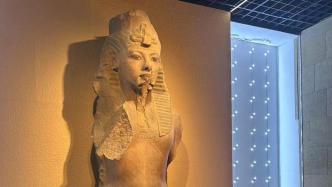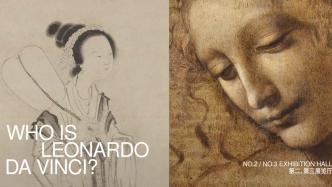
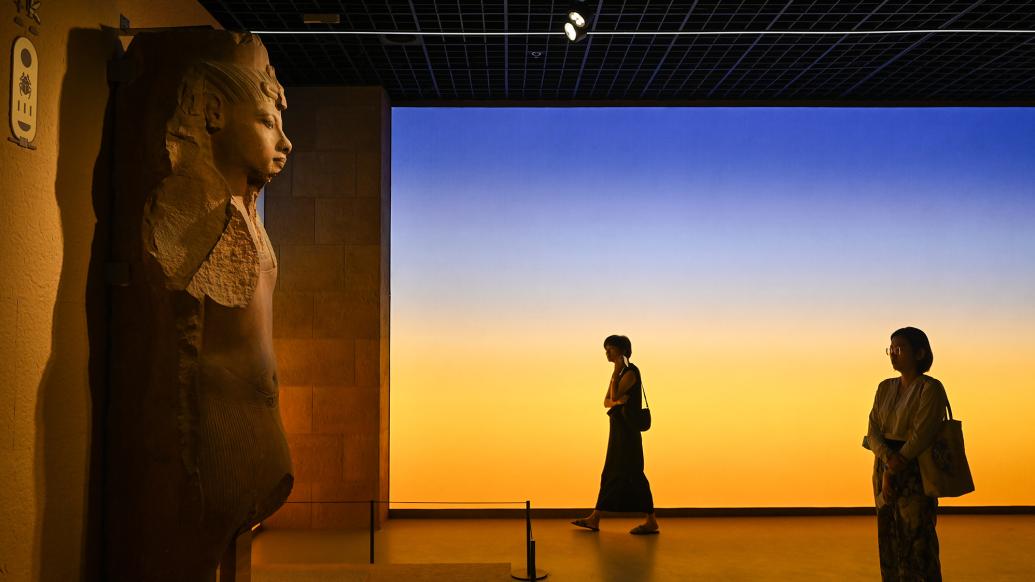
On July 17, the fourth exhibition of the Shanghai Museum's "Dialogue with the World" cultural relics and art exhibition series, "Top of the Pyramid: Ancient Egyptian Civilization Exhibition", officially opened at the People's Square Museum and will be open to the public on July 19. Following the debut of the first section of the exhibition , "The Kingdom of the Pharaohs" yesterday, the other two sections of the exhibition, "The World of Tutankhamun" and "The Secrets of Saqqara", were also officially unveiled today.
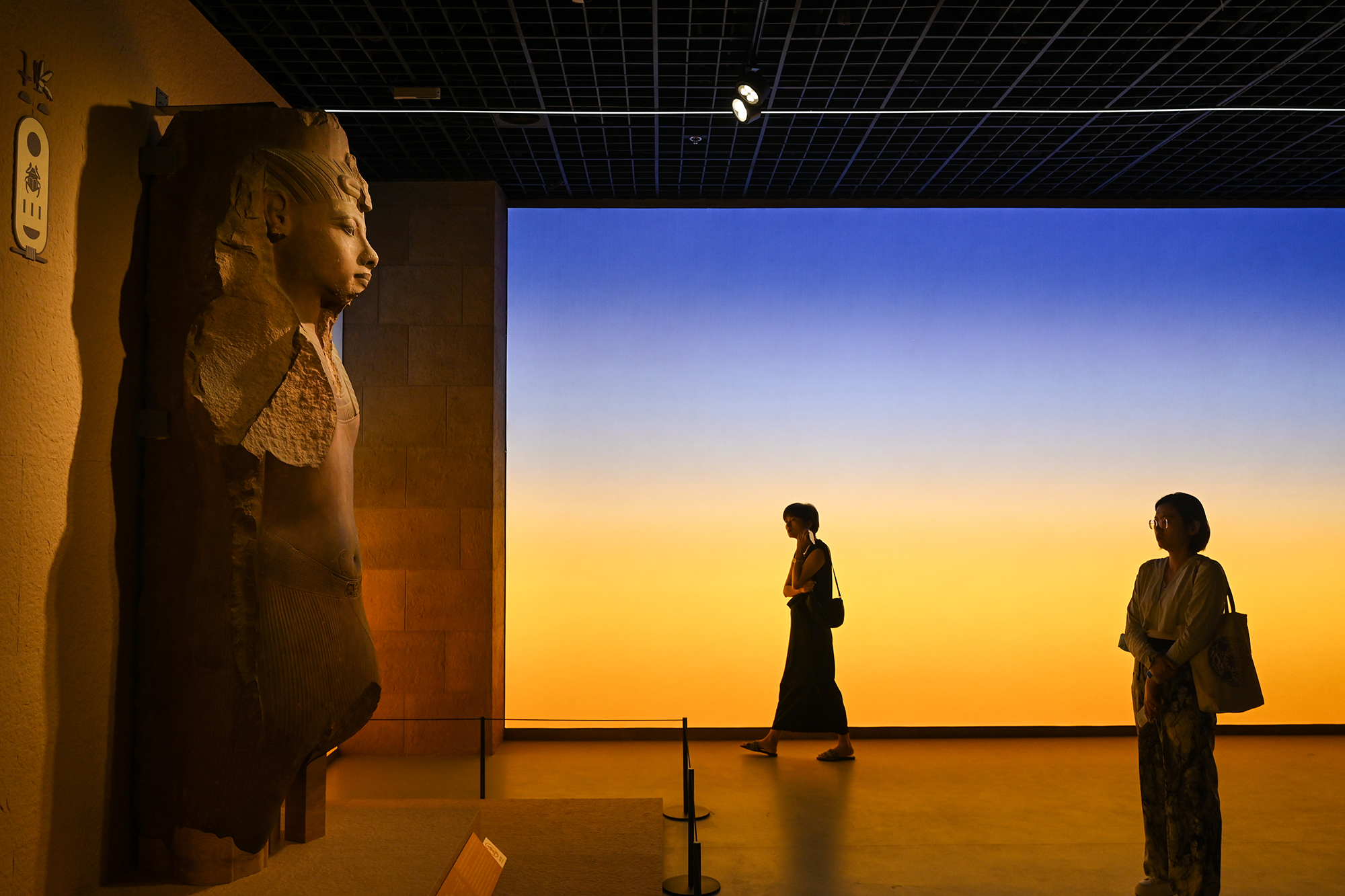
July 17, 2024, "The Age of Tutankhamun" exhibition hall at the Shanghai Museum. Photo by Zhu Weihui, a reporter from The Paper
Rereading the legendary life of the young Pharaoh
In 1922, the tomb of King Tutankhamun was discovered in the Valley of the Kings in Thebes. Nearly 5,000 precious cultural relics were unearthed in the tomb, which was luxurious and spectacular, triggering "Egypt fever" around the world. What kind of transformation was happening in ancient Egypt during the 18th Dynasty when Tutankhamun lived? How to interpret the legendary life of Tutankhamun, the young pharaoh? This section will focus on the legendary life of Tutankhamun and the turbulent times he lived in.
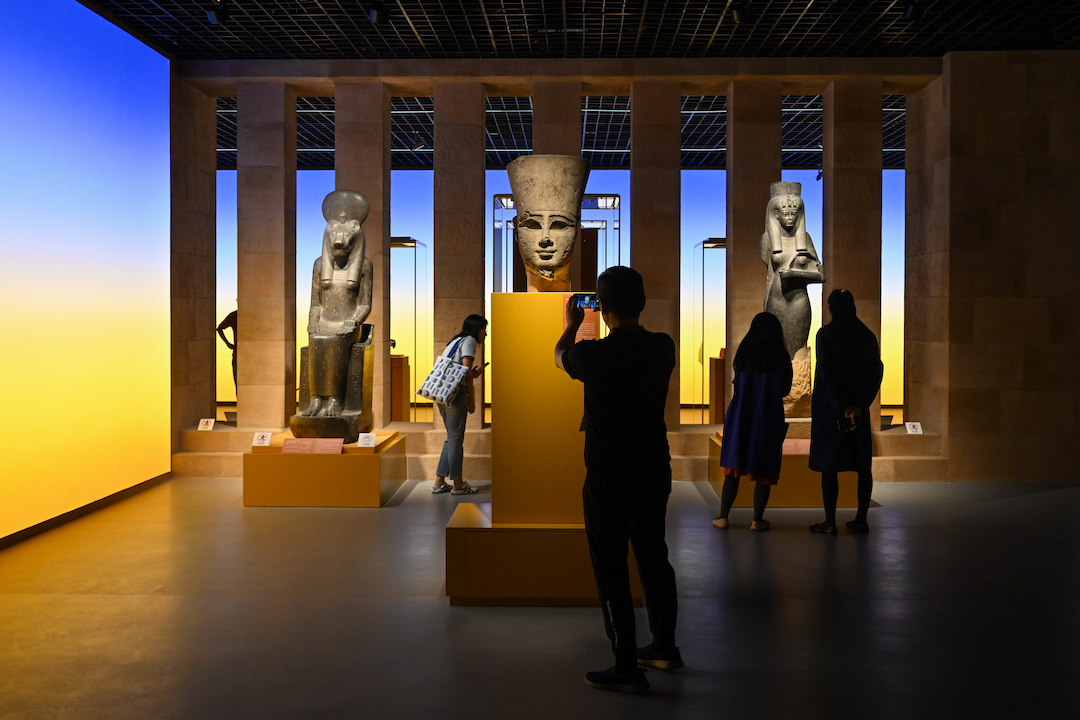
July 17, 2024, "The Age of Tutankhamun" exhibition hall at the Shanghai Museum. Photo by Zhu Weihui, a reporter from The Paper
Passing through a long tomb passage, it seems as if time and space were pulled back to the scene when Tutankhamun's tomb was discovered in the Valley of the Kings in Luxor in 1922. There are not many exhibits in this exhibition hall, and the exhibition space design leaves enough space, giving people a poetic and soothing narrative rhythm.
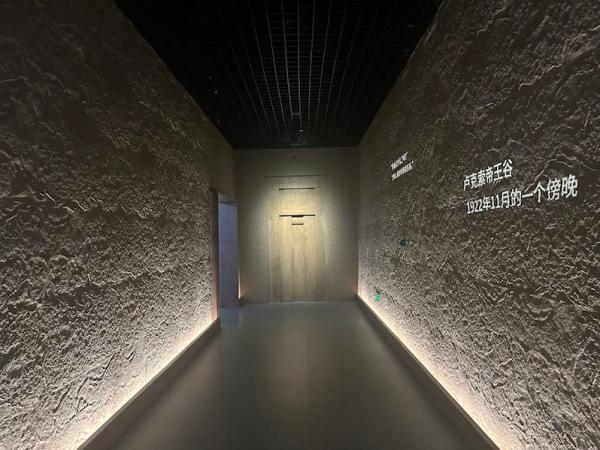
July 17, 2024, Shanghai Museum, "The Age of Tutankhamun" exhibition hall.

July 17, 2024, "The Age of Tutankhamun" exhibition hall at the Shanghai Museum. Photo by Zhu Weihui, a reporter from The Paper
Although this exhibition hall does not have many exhibits, only dozens of pieces, it brings together related exhibits of several of the most famous historical figures in ancient Egyptian history, including a giant statue of Tutankhamun, a colossal statue of Tutankhamun's father Akhenaten, a statue of his mother Nefertiti, as well as a standing statue of Akhenaten's mother, Queen Tiye, the wife of Amenhotep III, and the chair she used. It can be said that this exhibition hall brings together the cultural relics of Tutankhamun's entire family.
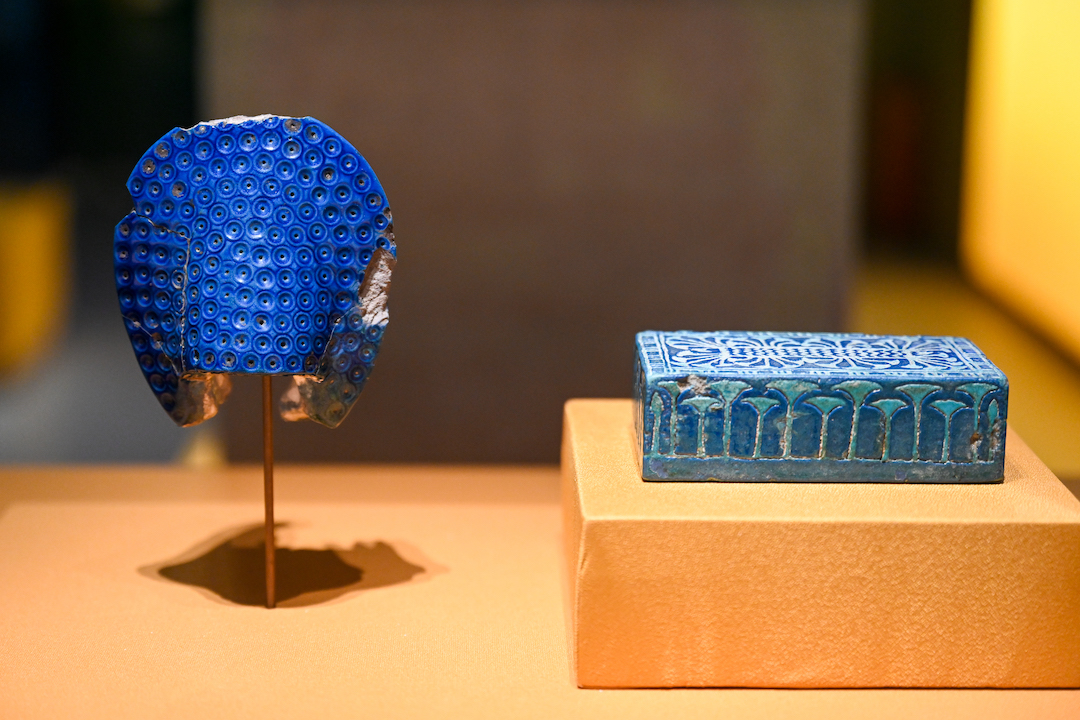
July 17, 2024, Shanghai Museum, blue crown (left), with papyrus pond pattern (right). Photo by Zhu Weihui, reporter of The Paper
The 18th Dynasty, in which Akhenaten and Tutankhamun lived, was a special period in the history of ancient Egypt. During this period, the first sprouts of monotheism appeared in the history of ancient Egypt. Tutankhamun's father Akhenaten moved the capital to Amarna and promoted religious reforms from polytheism to monotheism. He rejected all gods and worshipped Aten alone. After Akhenaten's death, his new religion soon ended. During his reign, Tutankhamun ended his father's monotheism and returned to tradition. "This family has undergone a great transformation, and Tutankhamun is at this time point of returning to tradition. The exhibition reveals the rich stories behind it through a series of related cultural relics." Yan Haiying, chief curator of the exhibition, said.
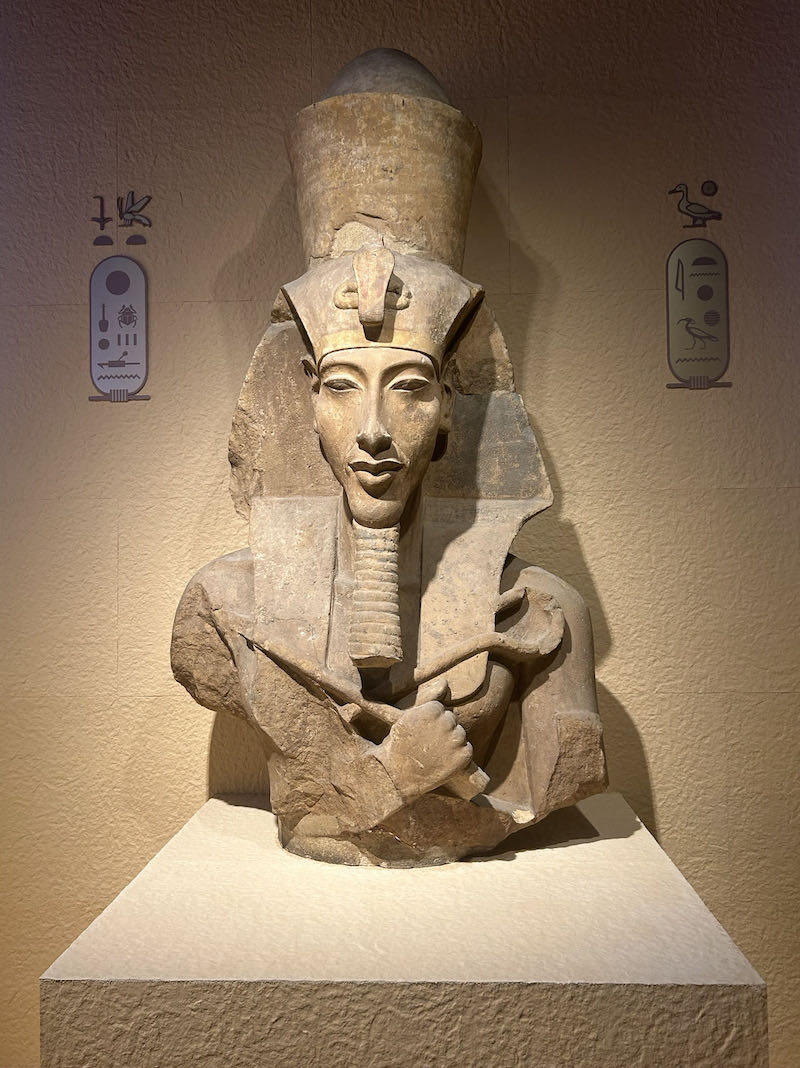
July 17, 2024, Shanghai Museum, Statue of Akhenaten.
During Akhenaten's reign, along with the religious reforms, traditional artistic norms were broken and a new artistic style was born, the "Amarna style". Akhenaten, his family, and his subjects were all depicted with long faces, broad foreheads, thick lips, narrow shoulders, and big bellies, achieving a complete separation between gods and humans in terms of image.
The colossus of Akhenaten on display is a typical "Amarna style" sculpture. This colossus is one of a group of statues with the same shape. This group of king colossi is about four meters high and once stood in an Aten temple to the east of the Karnak Temple. Different from the heroic and muscular style of traditional king statues, Akhenaten's image is feminine, with narrow eyes and chin.

July 17, 2024, Shanghai Museum, Nefertiti head. Photo by Zhu Weihui, reporter of The Paper
Another exhibit that is full of Amarna-era art features is the "Head of Nefertiti". Nefertiti was Akhenaten's queen and one of the most famous queens in Egyptian history. A "Bust of Nefertiti" unearthed in 1912 is the most famous and controversial ancient Egyptian artifact today, and is now collected in the Berlin Museum in Germany. The "Head of Nefertiti" on display has realistic details and soft lines. Although the nose is slightly damaged, it still cannot hide her elegant appearance.
Opposite the Colossus of Akhenaten, facing it from a distance, is the "Colossus of Tutankhamun, appropriated by Aye and Herembu". This statue was discovered by the Chicago archaeological team in 1931 in a funerary temple that was built during the Aye period and completed during the Herembu period. There were two statues when they were discovered, one of which was relatively intact and is now collected in the Egyptian National Museum, while the other was severely damaged when it was unearthed and is now stored in the Oriental Institute of the University of Chicago after restoration.

Tutankhamun statue at Shanghai Museum on July 17, 2024. Photo by Zhu Weihui, a reporter from The Paper
The curator of this exhibition, Xue Jiang, a researcher at the Institute of World Art History of Shanghai International Studies University, believes that the giant sculpture of Tutankhamun on display is a cultural relic that has been seriously underestimated by the Egyptology community. It is one of the few sculptures of Tutankhamun left over from his reign and is "extremely exquisite and shocking."
Tutankhamun is one of the most famous pharaohs in the history of ancient Egypt. He ascended the throne at the age of 9 and died at the age of 19. He left many unsolved mysteries after his death, and there is no consensus on the evaluation of his historical achievements.
"Tutankhamun is a very special pharaoh in Egyptian history. He was a young pharaoh who succeeded to the throne in childhood but died in youth. Many people think that Tutankhamun was a pharaoh who did nothing, but this young pharaoh did a lot during his short reign. He broke the monotheism founded by his father and returned to tradition. He moved the capital back to Memphis and reconstructed the dynasty order." Xue Jiang said that specifically in the statue of Tutankhamun, it also changed the old-fashioned and stylized features of the pharaoh statues in the Old Kingdom and the Middle Kingdom, presenting a perfect combination of realism and ritual. "From the original divinity to humanity, although the face of the sculpture is incomplete, the shape is lifelike like a real person."

Relief of Akhenaten and his family at the exhibition site (center)
The "Relief of Akhenaten and his Family" on display vividly depicts the scene of Akhenaten and his family performing a ceremony for the god Aten. It is a vivid reproduction of the historical event in which Akhenaten exclusively revered the god Aten.
Latest archaeological findings from Saqqara unveiled for the first time
"The Secrets of Saqqara" tells the latest archaeological discoveries in the Saqqara area and is also a highlight of the exhibition.
Saqqara is the most important cemetery in Memphis, Egypt's oldest capital. It houses the first pyramid in Egyptian history, the Step Pyramid of Djoser, as well as 15 pyramids from the 3rd to 13th dynasties, as well as many noble tombs and animal mummies from different periods. Since 2018, the Egyptian archaeological team has made major discoveries in Saqqara, which was named one of the "Top Ten Archaeological Discoveries in the World" in 2020.
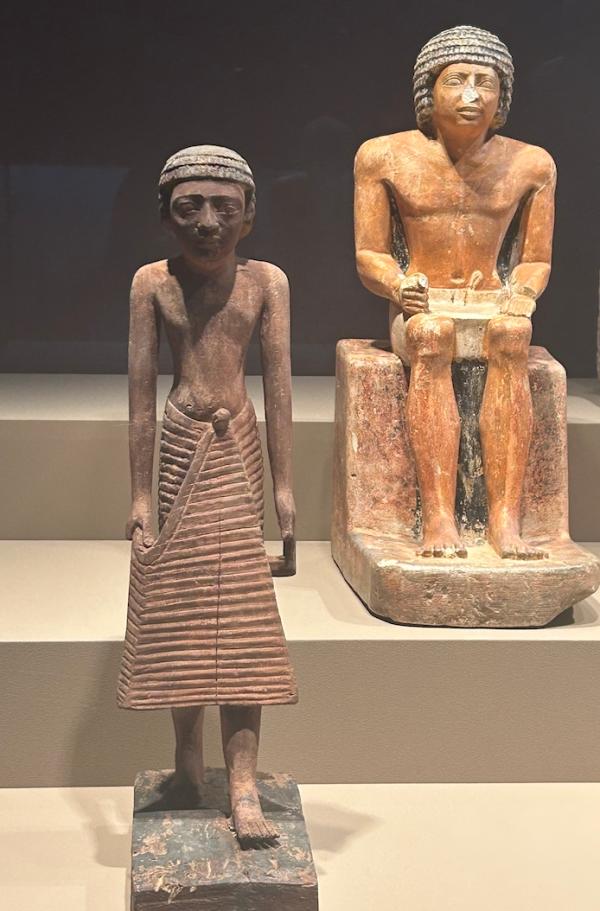
Portraits from the Old Kingdom on display
According to Xue Jiang, "The Secret of Saqqara" shows the latest archaeological discoveries in Saqqara. The two most important discoveries are cat mummies and painted wooden coffins. The painted wooden coffins were unearthed to the north of the step pyramid of Saqqara, near the temple of the cat goddess Bastet, dating from the 26th Dynasty (664-525 BC) or later. Many of the ancient tombs here were reused by the ancient Egyptians to bury a large number of cat mummies for vows.

The "painted human-shaped coffin" unearthed from the Saqqara site on display
The exhibition displays the latest painted human-shaped coffins unearthed from the Saqqara site. These painted wooden coffins were unearthed from three 12-meter-deep shaft tombs. There are more than a dozen colors of faces alone, and 10 of the wooden coffins on display were even selected by the curatorial team in person in the ancient tombs. "After we were lowered from the shaft tombs, these coffins were stacked layer by layer, with the highest stacked up to seven layers. We selected some representative samples to exhibit." Xue Jiang said that these batches of human-shaped painted wooden coffins are all first-hand materials and have not yet been published to the world. They are precious materials for the study of coffin typology and the construction of databases.
The many cat mummies, seated cat statues and cat head statues wrapped in linen on display were also brought directly to the Shanghai Museum exhibition hall after being excavated from the ruins of the Cat Temple. The Shanghai Museum exhibition hall was also built in the style of the Cat Temple.
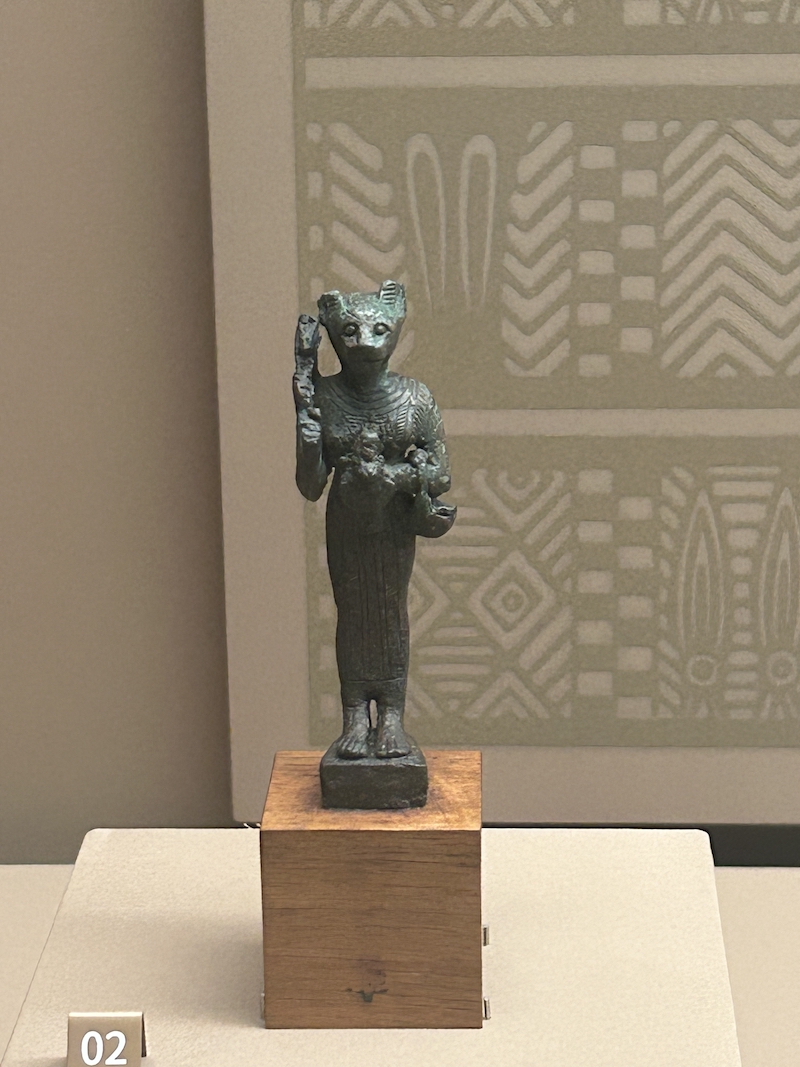
Various cat-god images on display: Bastet holding a fork and bell
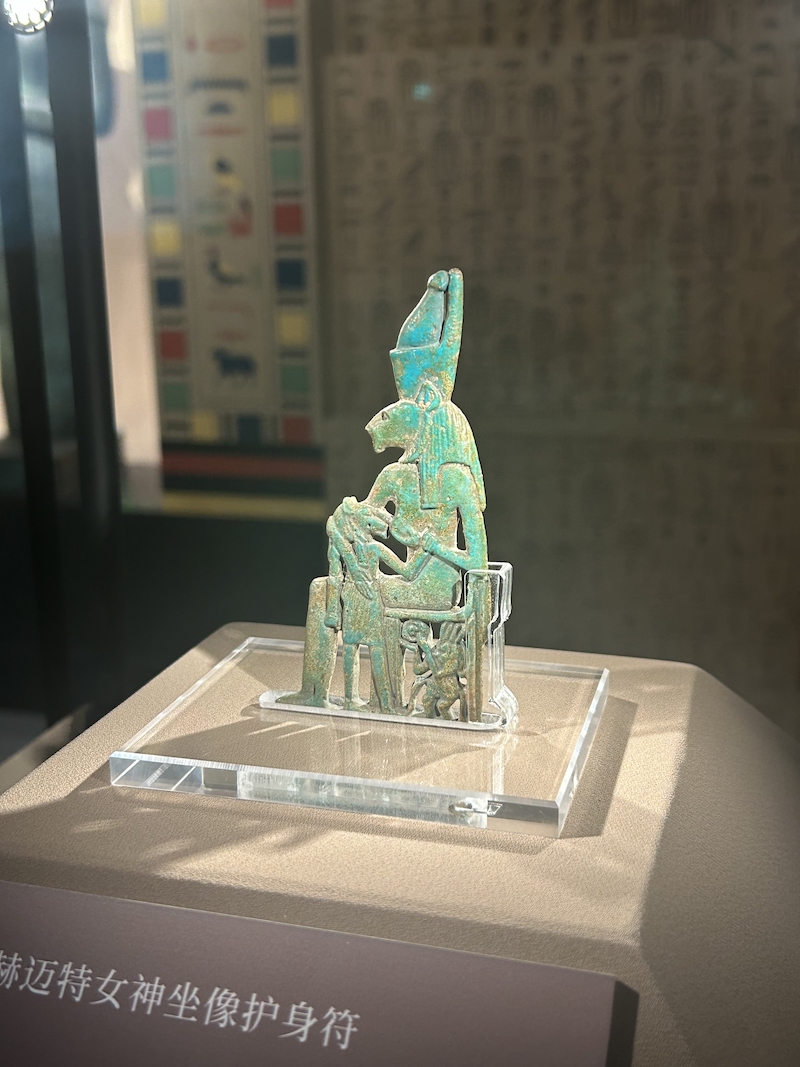
Various cat statues and Sekhmet amulets on display

Various cat statues are on display, including the Bastet statue
"The exhibits in this section are the latest archaeological discoveries in the Saqqara area. After being excavated from the archaeological site and simply cleaned in the warehouse, they were sent to Shanghai for exhibition. It can be said that the Egyptian government broke the precedent by loaning new archaeological discoveries to Shanghai." Yan Haiying said, "The Egyptian side believes that Egypt's independent archaeology has done a very good job in recent years. They hope that more people will understand their work. They generously introduced some of their new archaeological discoveries in recent years to us. This shows that the Egyptians have a great trust in us. At the same time, they also hold this purpose, hoping that the descendants of the ancient civilization will have more consensus on the study of ancient civilization."
The exhibition will last for nearly 13 months, until August 17, 2025.
